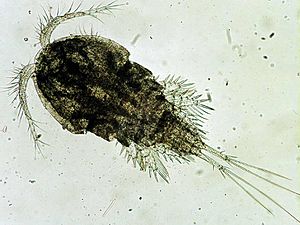Maxillopoda facts for kids
Quick facts for kids MaxillopodaTemporal range: Cambrian to Recent
|
|
|---|---|
 |
|
| Cyclops (Copepoda: Cyclopoida) | |
| Scientific classification | |
| Kingdom: | |
| (unranked): | |
| Phylum: | |
| Subphylum: | |
| Class: |
Maxillopoda
Dahl, 1956
|
| Sub-classes | |
|
|
Maxillopoda is a group of crustaceans that includes many different kinds of animals. You might know some of them, like barnacles and copepods.
Scientists don't think Maxillopoda is a single, unified group from one ancestor. This means there isn't one special feature that all members share.
What are Maxillopods Like?
Most maxillopods are very small. In fact, the smallest known arthropod, called Stygotantulus stocki, is a maxillopod! Some barnacles can be bigger, but generally, these creatures are tiny.
They often have short bodies. Their abdomen (the back part of their body) is usually very small and doesn't have many appendages (like legs or feelers). This might be because they keep some features from their younger, larval stages.
Most maxillopods use their maxillae (special mouthparts) to eat. Barnacles are different; they use their legs to filter feed, which means they catch tiny bits of food floating in the water.
A typical maxillopod body has 5 parts in its head, 6 parts in its middle section (called the thorax), and 4 parts in its abdomen. At the very end, they have a tailpiece called a telson.
Maxillopods in the Past
We know about maxillopods from a long time ago because of their fossils. Their history goes back to the Cambrian period. This was a very, very long time ago!
Scientists have found fossils of barnacles and even tongue worms from that ancient time. This shows that maxillopods have been around for millions of years.
How Maxillopods are Grouped
Scientists usually divide Maxillopoda into six main smaller groups, called subclasses. Some of these groups are:
- Mystacocarida: These are tiny crustaceans that live freely in the sand between ocean grains.
- Tantulocarida: These are all parasites, meaning they live on or in another animal and get their food from it.
- Pentastomida: Also known as "tongue worms," these are also all parasites.
- Branchiura: These are often called "fish lice" and are parasites that live on fish.
- Copepoda: Many copepods are free-living, but some are parasites.
- Thecostraca: This group includes barnacles. Many barnacles are free-living, but some are also parasites.
So, while some maxillopods live on their own, many of them have a special way of life where they depend on other animals for survival.
See also
 In Spanish: Crustacea para niños
In Spanish: Crustacea para niños

